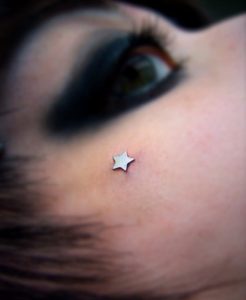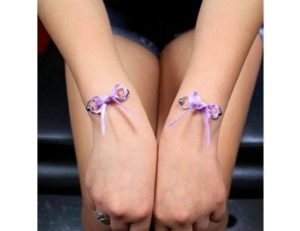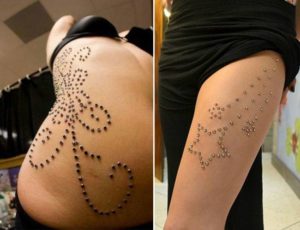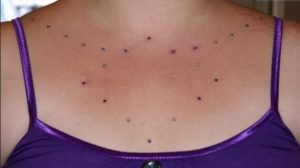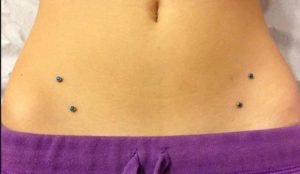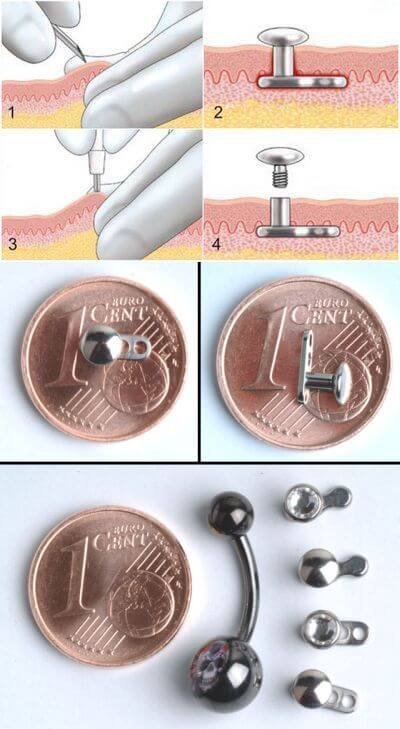Dermal Piercing
Dermal piercings are the new rage in the body art industry. Because only the stud or jewelry is visible you can put them almost anywhere on your body.
There are quite a few common complications but when placed by trained individuals and with proper aftercare they can be very safe. There are various names that you may use for this type of body art such as dermal anchoring, microdermal piercings, and skin divers. In this article, you will get answers to the most common questions about dermal piercings.
Why do people choose dermal piercings?
- Artistic expression
- Religious reasons
- Sexual practices
- Physical appearance
• Rites of passage
• Cultural reasons
How can you define dermal piercing?
- One dermal piercing definition is the placement of jewelry into a whole or perforation made into the skin or dermal tissue.
- According to most health department regulations, dermal piercing falls under body piercing and should follow the same safety regulations.(5)
How much should Dermal Piercing cost? What are dermal piercing prices?
- Prices will be very different depending on where you live. Below is a general estimate but is not exact.
- In the UK costs can be between $70 to $100 and this does not always include the jewelry. Jewelry can cost as much as $25 to $75.
- Prices in the US are similar. Depending on the placement and how many jewels you want the price can range from $40usd to around $100usd.
- Depending on the studio will depend on if you have to pay for the jewelry separate. (6)
What are the possible locations of dermal piercings? (Dermal Piercing Locations).
- Due to the nature of the dermal piercing they can be placed almost anywhere on your body. They are very different from normal piercings.
- Regular piercing needs and entrance and an exit and can be placed in the following areas.
- Nipple
- Navel
- Genital
- High ear
- Tragus
- Nostril
- Septum
- Eyebrow
- Tongue
- Lips
- Cheek
The images below show some of the normal body piercing for genital and nipple piercing which is not the same as dermal piercing.
Image : https://www.ncbi.nlm.nih.gov/pmc/articles/PMC1496593/figure/fig3/
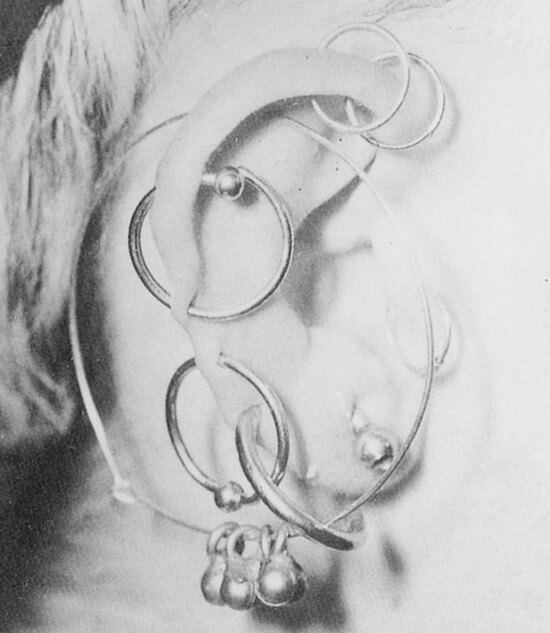
Photo : In this image, you can see various locations of ear piercings.
Image source : www.ncbi.nlm.nih.gov
As stated above Dermal piercings could be placed almost anywhere. Here you will see various locations and examples of typical dermal piercings.
- Face
In this image, the dermal piercing is placed on the cheek close to the eye. Many of the face dermal piercings are placed to accent facial features.
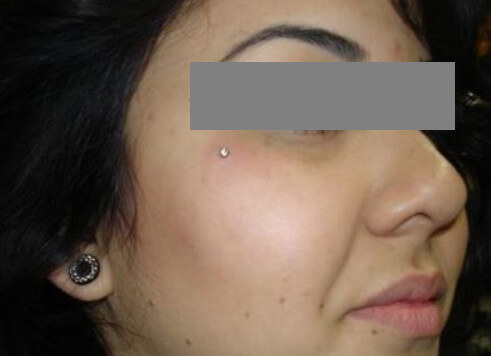
Image Source – healcure.org
Here the piercing is placed directly to cause a dimple. Again accenting facial features.
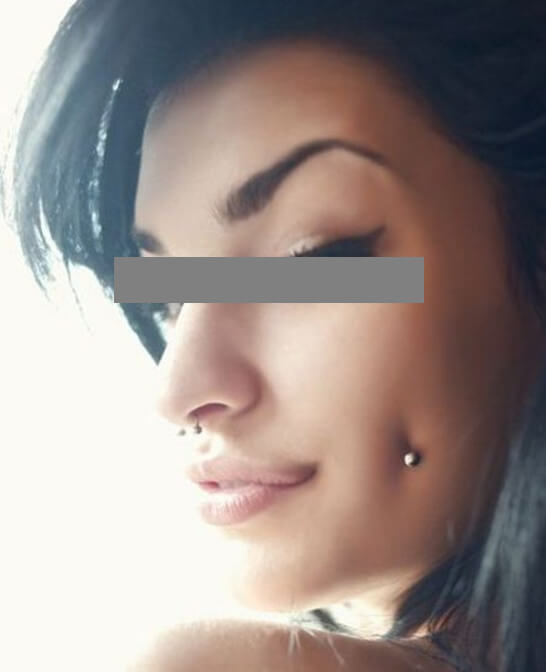
Image Source – healcure.org
This facial placement is the same as the first image but the jewelry is different giving it a different look.
- Spine
In this image, you can see normal piercings. This is not the dermal piercing using an anchor. In this piercing, there is an entrance and an exit for the jewelry which is then decorated with ribbon to appear like a dress or lingerie.
This image shows spinal dermal piercing. Here the dermal anchors are placed directly over the spinal column. As with most dermal piercings, it is considered to accent normal body parts.
In this image, the spinal dermal placement is not directly over the spinal column. Instead, heart images were created along the entire back. The sizes of the hearts accentuate the female curve.

Image source – healcure.org
In this last spinal dermal piercing placement you can see a simple design. Here the placement is directly under the hair.
- Umbilical
In this image you can see two umbilical piercings. The top one is a normal piercing which has an entrance and an exit site. The piercing on the bottom of the umbilical area is the dermal piercing. Also noted in this image are the abdominal piercings meant to accentuate the pelvic region.
 Image source – piercingtime.com
Image source – piercingtime.com
- Extremities
This image shows dermal piercings which include hoops instead of jewelry holding only a stud. In the hoops, they have connected ribbon to create the bow.
In this, image the dermal piercing is placed on the finger to represent a ring.
 Image source – piercingmodels.com
Image source – piercingmodels.com
Here an intire design has been place on the leg and along the abdomen. Really with dermal piercing any use can creat a new artistic design.
- Chest
Again and artistic design created to accentuate the chest área has been created.
In, this, image the artistic design was not used as much as accentuating the woman’s chest.

- Pelvic area
As noted in the above image this dermal piercing placement is made to accentuate the pelvic region of the female.
Dermal Piercing Procedure
- First off the person placing a dermal piercing should be a trained professional.
- Dermal piercing is an aseptic procedure. But if the specialist prefers sterile gloves may be used. (5)
- Items needed – (Dermal punch, Piercing needle, Scalpel (not always needed), Anchor, Jewelry, Forceps)
- First step always should be hand hygiene by the piercing specialist.
- Next the site needs to be cleaned.
- Piercing equipment should already be sterilized
- If a dermal punch is being used it takes out a bit of dermal tissue to leave space for the anchor.
- Some specialists choose to use a needle. In this case the needle creates an L-shaped area under the dermal tissue. The forceps are then used to raise the skin and the ancho placed in.
- Some specialist may use anesthetics to help numb the area before the piercing is placed.
- Again this procedure should always be done by someone who has been trained in the art. (6)
- Lastly a breathable bandage may be placed over the site.
This image shows dermal piercing placement using a needle to create the opening.
Image source – primehealthchannel.com
- In minors
- A parent and or legal gardian should be present and needs to sign release forms.
- There may be specific state laws regarding piercing of minors.
- Parents must provide identification showing legal coverage of the minor.
- Minors should never receive piercings on private areas of the body. (5)
Dermal Piercing Aftercare
- Aside from proper procedure aftercare is the next most important issue regarding dermal piercing.
- Proper after care is the best way to prevent infection and or keloid growth.
- If a bandage was placed, this can be removed a couple days after placement.
- If you are involved in any physical sports or activities be sure to cover the dermal piercing with a fresh breathable bandage.
- Always wash your hands very well and use antibacterial soap before touching the dermal piercing.
- The piercing should not be manipulated for at least 3-6 months. This includes not changing the jewelry.
- Avoid it being pulled on by clothing or towels. This could cause migration of the anchor, or keloid formation.
- It is a good idea to cover the piercing when showering to avoid it getting wet.
- You should not need to remove dermal piercings for tests such as MRI, CT scans or Xrays.
- If you note swelling or have a lot of pain you can take ibuprofen.
- Zinc and arnica help with healing process.
- Dermal piercing cleaning should be done with a piercing solution.
- Drying your dermal piercing should be done with a clean paper towel or napkin.
- Do not use anti-septic or anti-bacterial solutions directly on the dermal piercing. This can cause excessive drying of the skin and scaring.
- If you notice scabbing, you can remove it by soaking it with piercing liquid until it is soft and gently wiping it away. Do not pick off scabs! (6)
Removal
- A dermal piercing will stay in for many years if given proper care.
- They should always be removed by an expert. Never try it on your own because it can cause infection or scaring.
- The process of removal starts with tissue massage in hopes to dislodge the anchor.
- If the anchor had holes in it the process may be more complicated. The holes are specifically made to prevent migration or movement of the anchor.
- Removal will always involve incisions of the tissue in order to displace the anchor
- There is pain involved in the process.
- Many studios may charge between $10-$15 to remove each anchor. If it is a difficult removal process you may have to the go to the doctor and the price will be more.
- After care for removal is very important to prevent scaring and infection. Be sure to follow all after care instructions given. (6)
Dermal anchor
- Varios times in this article the anchor has been mentioned. You may be wondering what exactly that is.
- It is like the back of your earing but it is flat and is placed under the skin.
- It is what the jewelry is placed into.
- It is not a subdermal or transdermal implant.
- As seen in the image below it is very small. (5)
Image source – wiki
Does Dermal Piercing Hurt?
- Dermal piercing does involve pain. Each person experienes pain differently therefore it is difficult to express the amount of pain involved.
- Some have considered it a 5-7 on a pain scale of 1-10. One is not painful and 10 is the most pain possible.
- The location of the piercing as with other types of body art changes the pain level quite a bit.
- It has been noted that microdermal punch is less painful than the needle insertion.
- The initial pain of placement only lasts a little while. (6)
Dermal piercing complications and Risks
Due to improper placement and poor after care there are many complications that can be noted with dermal care.
- Less drastic complications include:
- Redness and swelling
- Drainage
- Bleeding
- inflamation
- More drastic complication can include
- Infection
- Cyst formation
- Allergic reactions
- Trauma
- Large scaring- Keloid formation
- Edema
- Hematoma
- Embedded jewelry
- Migration or rejection (2)
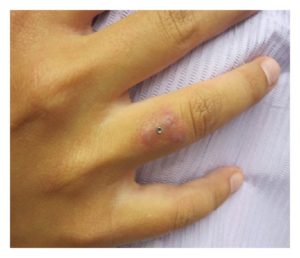 Image source – ncbi.nlm.nih.gov
Image source – ncbi.nlm.nih.gov
These two images show the infected dermal piercing and the scaring noted after the piercing was removed and the area treated.
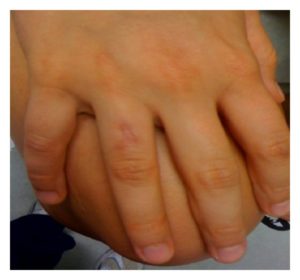 Image source – ncbi.nlm.nih.gov (1)
Image source – ncbi.nlm.nih.gov (1)
Dermal Piercing Infection Infections which include and are not limited to:
- Mycobacterium fortiutum- a rapid growth of nontuberculous mycobacteria (1)
- Impetigo
- Cellulitis- infected dermal or subcutaneous tissue.(3,5)
- General Bacterial infections
- Streptococcal and staphylococcal infection
- Perichondritis infections including pseudomonal infections.
- Viral hepatitis (2)
Issues with metals
- Allergies to metals can cause contact dermatitis.
- Nickel allergy
- Gold sensitivity
- If you have a history of sensitivity to metals you can get a patch test done. (2)
Dermal Piercing Healing
- The healing process takes as long as three months. This depends on where it is placed and if it is well cared for.
- Regection may occur during the first three month period. (6)
- Dermal Piercing Scars (2)
This image shows keloid formation.
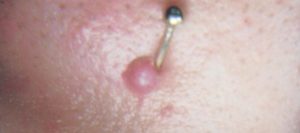 Image source – ncbi.nlm.nih.gov
Image source – ncbi.nlm.nih.gov
In this, the image you can see cellulitis infection of the ear due to piercing.
 Image source – ncbi.nlm.nih.gov
Image source – ncbi.nlm.nih.gov
In this, image the tissue is inflamed due to the piercing.
 Image soruce – ncbi.nlm.nih.gov
Image soruce – ncbi.nlm.nih.gov
Dermal Piercing Video
- The following link will show the process of collar bone dermal placement.
https://www.youtube.com/watch?v=v5_woTSS3Bo - This link is to a video that can show the complete process of face dermal piercing.
https://www.youtube.com/watch?v=TL2wMeolzdE
References :
- http://www.ncbi.nlm.nih.gov/pmc/articles/PMC3773381/
- http://www.ncbi.nlm.nih.gov/pmc/articles/PMC1496593/
- http://www.ncbi.nlm.nih.gov/pmc/articles/PMC1071670/
- http://www.cdc.gov/niosh/topics/body_art/more-info.html
- http://www.safepiercing.org/learn/piercing/faq/
- http://www.healcure.org/piercing/dermal-piercing/microdermal-piercing-price-pictures-removal-jewelry-on-hip-neck-back-chest/
- https://en.wikipedia.org/wiki/Transdermal_implant#Microdermal_implants
- http://www.ncbi.nlm.nih.gov/pmc/articles/PMC3773381/
- http://www.webmd.boots.com/healthy-skin/guide/body-piercing-risks
Published by Dr. Raj MD under Uncategorized.
Article was last reviewed on August 6th, 2018.

